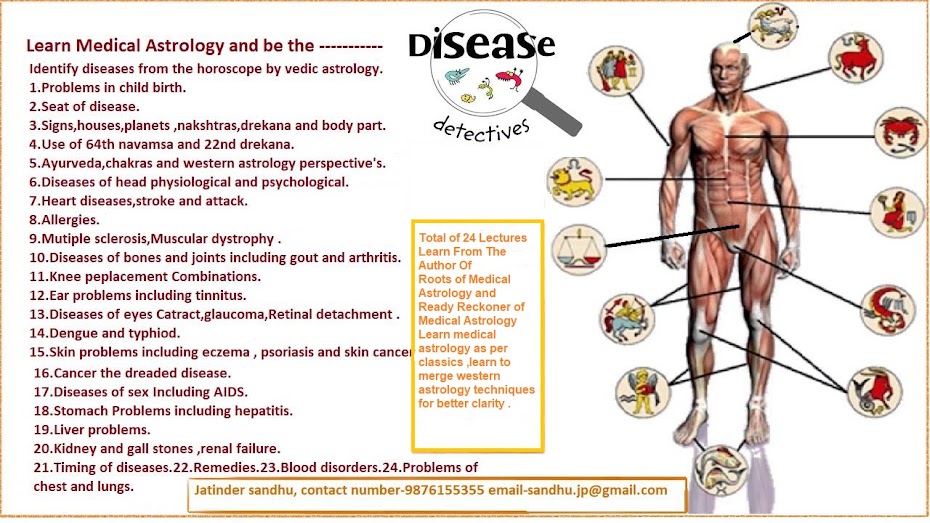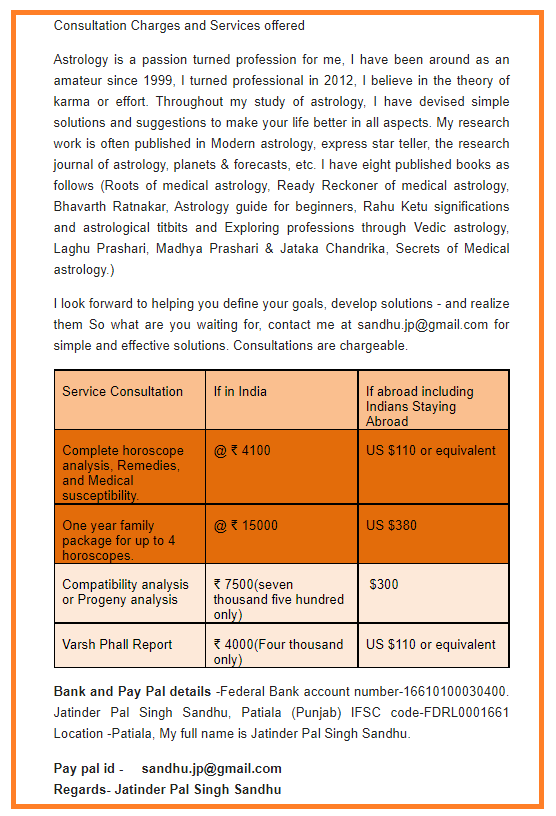Dhatu, Moola & Jeeva Divisions of planets and diseases.
Dhatu, Moola & Jeeva Divisions of planets
In chapter 3 of Brihat Parashara Hora Shashtra, the sage Parashara has provided a very detailed description of planets and their respective characters. The humanization of the planets is done in order to have an in-depth understanding of the role and activity of the planets in our life.
In verse number 47 - the sage Parashara has classified the planets on the basis of Dhatu, Moola, and Jeeva.
In verse number 47 - the sage Parashara has classified the planets on the basis of Dhatu, Moola, and Jeeva.
Dhatu means metal and is basically related to the materialistic role of planets in the birth chart.
Moola means the roots, and Moola division is related to the existence of the self in the world.
Jeeva means living beings and is basically related to the relationships of the native.
Moola means the roots, and Moola division is related to the existence of the self in the world.
Jeeva means living beings and is basically related to the relationships of the native.
The Planets Rahu, Mars, Saturn, and the Moon are lords of Dhatu in the birth chart.
The life-giving Planet Sun and the Venus are the lords of Moola.
Remaining planets viz. Mercury, Jupiter and Ketu rule over Jeeva.
The life-giving Planet Sun and the Venus are the lords of Moola.
Remaining planets viz. Mercury, Jupiter and Ketu rule over Jeeva.
Planets
|
Dhatu/Upadhatu
|
Sun
|
Asthi (Bones)
|
Moon
|
Rakta (Blood)
|
Mars
|
Majja (Bone Marrow)
|
Mercury
|
Twacha (Skin)
|
Jupiter
|
Vasa (Adipose tissue)
|
Venus
|
Shukra (Semen/Sperm)
|
Saturn
|
Snayu (Muscle)
|
Associated with planetary influences are the ailments affecting the portion of the body represented by the Sign position of the planet - at birth, in transit, or by direction; and by the Signs and Houses ruled by the planet.
Planets
|
Corresponding Ailments
|
Sun
|
Ailments of heart and upper spinal region; fevers and breaking down of tissues; fainting spells; diseases of the spleen.Circulatory deficiencies, Anaemia Indigestion
|
Moon
|
Endocrine imbalance resulting in inflamed glands and defective eyesight; functional ailments and irregularities; allergies; mental instabilities; female disorders; Lunacy, emotional depression
|
Mars
|
Constipation, Flatulence, Liver trouble, Blind piles, Skin Trouble
|
Mercury
|
Nervous Disease, Ulcers, Acidity, Blood Pressure, Restlessness, Irritation
|
Jupiter
|
Jaundice, Biliousness, chronic acidity, Colic Problems Palpitation, Toothache, Insomnia
|
Venus
|
Bronchial disorder, Whooping Cough, Asthma, Dyspepsia, Sexual ailments, Delirium, Obsessions
|
Saturn
|
Neurosis, Neuralgia, Sciatica, Rheumatism, Excretory disorders
|
Rahu
|
Hyperacidity, Burning Sensations, Brain Disorders, Sexual Excesses, Drinking Problems
|
Ketu
|
Skin Disorders, Nervous Debility, Small Pox, Urinary Tract Infections
|
Dhatu are basically the body tissues which are responsible for the functioning of the systems and organs and the structure of the body. Each of the Dhatus is built out of a previous one and they develop on the nourishment that comes from the digestive system. They are basically the result of the action of catalysts that convert one tissue to another. The sole purpose of metabolism is to assemble proper 'Dhatus' together in synchronization with which they carry out their role as the field of physiological activity.
Seven Dhatus Of Ayurveda
Dhatu is originally a Sanskrit word which means 'that which enters into the formation of the body'; the root Daa means 'support' or 'that which bears'.It is thus said to be the base of growth and survival. According to Ayurveda, there are seven basic types of dhatus in the human body. This seven basic dhatus are composed of five mahabhutas. These dhatus remain inside the human body in a proper equilibrium so that the body can function properly. It is said that any kind of disturbance or imbalance in their equilibrium causes ailments and diseases. The seven dhatus are as follows:
Rasa (Plasma)
Rasa literally means 'sap' or 'juice'. The primary function of 'Rasa' is to strengthen 'rakta' (blood) and provide nourishment. Basically, the tissue fluids consist of lymph and blood plasma. Accessory tissues are breast milk and the menstrual blood.
Rakta (Blood)
Rakta Dhatu is said to be constituted from the metabolic refinement of the Rasa Dhatu. The primary function of the Rakta Dhatu is the nourishment of the body. It is also said to be the preserve of life.
Mansa (Muscles)
It is formed from the rasa and rakta dhatu and said to be the basic cover of bone and structure of the body.
Meda (Fat)
Meda Dhatu is the finer part of the mansa dhatu that is also known as fatty tissue. They keep the lubrication between the various body organs and help the body in maintaining the right internal temperature.
Asthi (Bone)
Asthi i.e bones are the finer essence of the Meda Dhatu, which are converted into the most solid form of the Dhatus. They give the basic structure to the body.
Majja (Bone marrow)
Majja is the finer essence of the Asthi Dhatu. It is basically a semi-solid substance, yellow and red in color. Its primary function is filling the bone. It is also found inside the brain and spinal cord.
Shukra (Reproductive fluid or Semen)
Sukra is produced from the most refined essence of the Bone Marrow. It is the cause of Ojas, which is actually the essence of all the seven Dhatus. The Shukra is responsible for the vitality and energy of the body.
Seven Dhatus Of Ayurveda
Dhatu is originally a Sanskrit word which means 'that which enters into the formation of the body'; the root Daa means 'support' or 'that which bears'.It is thus said to be the base of growth and survival. According to Ayurveda, there are seven basic types of dhatus in the human body. This seven basic dhatus are composed of five mahabhutas. These dhatus remain inside the human body in a proper equilibrium so that the body can function properly. It is said that any kind of disturbance or imbalance in their equilibrium causes ailments and diseases. The seven dhatus are as follows:
Rasa (Plasma)
Rasa literally means 'sap' or 'juice'. The primary function of 'Rasa' is to strengthen 'rakta' (blood) and provide nourishment. Basically, the tissue fluids consist of lymph and blood plasma. Accessory tissues are breast milk and the menstrual blood.
Rakta (Blood)
Rakta Dhatu is said to be constituted from the metabolic refinement of the Rasa Dhatu. The primary function of the Rakta Dhatu is the nourishment of the body. It is also said to be the preserve of life.
Mansa (Muscles)
It is formed from the rasa and rakta dhatu and said to be the basic cover of bone and structure of the body.
Meda (Fat)
Meda Dhatu is the finer part of the mansa dhatu that is also known as fatty tissue. They keep the lubrication between the various body organs and help the body in maintaining the right internal temperature.
Asthi (Bone)
Asthi i.e bones are the finer essence of the Meda Dhatu, which are converted into the most solid form of the Dhatus. They give the basic structure to the body.
Majja (Bone marrow)
Majja is the finer essence of the Asthi Dhatu. It is basically a semi-solid substance, yellow and red in color. Its primary function is filling the bone. It is also found inside the brain and spinal cord.
Shukra (Reproductive fluid or Semen)
Sukra is produced from the most refined essence of the Bone Marrow. It is the cause of Ojas, which is actually the essence of all the seven Dhatus. The Shukra is responsible for the vitality and energy of the body.




